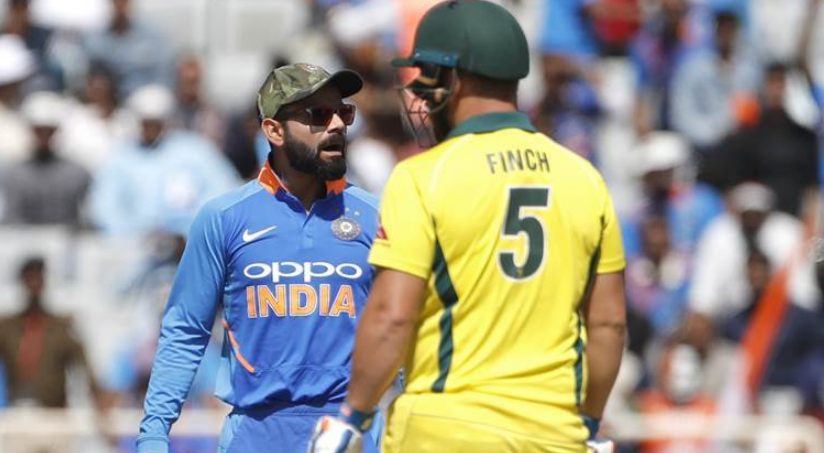On the Ball | India’s Series Loss Eye Opener On Curious Nature of Elite Sport

Aaron Finch-led Australia cricket team beat Indian cricket team 3-2 in the ODI series, Virat Kohli and Co’s last competitive series before the ICC World Cup in June.
For the last hour, you could have heard a pin drop at the Feroz Shah Kotla in New Delhi. You could have knocked the audience over with a feather. The unthinkable was unfolding in front of their eyes, their seemingly invincible heroes being driven to their knees.
Long before Marcus Stoinis knocked over Kuldeep Yadav’s middle pole to formalise a remarkable 35-run heist in the national capital, the celebrations had begun in the Australian camp. Aaron Finch’s men, who had lost every One-Day International series — home and away — since January 2017, came to India on a wing and a prayer, primed for a seventh consecutive series loss, against a side that had been beaten only once in its 13 previous bilateral showdowns.
Australia were without, inarguably, their two best batsmen, Steve Smith and David Warner (both still suspended), and their best limited-overs bowler, Mitchell Starc. And, when they went 0-2 down after imploding in Nagpur with the finish line in sight, the script was unfolding along expected lines.
Read More | On the Ball | IPL Franchise or Country: Indian Cricket’s Tug of War
Thereafter, driven by the scything willow of Usman Khawaja, they orchestrated one of the most sensational comebacks in recent times. Playing a brand of cricket conspicuous by its absence over the last two years and with scant regard for reputation or pedigree, they stunned India with their sustained and relentless ferocity. In the transformation of the hunted to the hunter was laid threadbare the glorious vicissitudes of limited-overs cricket.
India’s 2-3 surrender was their first loss in an ODI series at home since October 2015, when they were beaten by a similar margin by South Africa. The last time they had suffered three defeats on the bounce in their own turf was back in November 2009, also against Australia.
It’s against this unflattering backdrop that India will approach the ICC Cricket World Cup 2019. But, beyond these numerical jaw-droppers, will these losses actually impact their campaign in England and Wales this June-July?
No, almost certainly.
Apart from the first game in Hyderabad which they lorded by six wickets, India were well below their best. Perhaps, they were feeling the effects of a long season – they have been playing non-stop since June, when they embarked on twin tours of Ireland and England. Perhaps, several individuals relaxed mentally, aware that they had done more than enough to seal their World Cup berths. Perhaps, once they went 2-0 up, they took another series victory for granted. Perhaps, too, Australia played above themselves, stepping in to punish every Indian error, of which there were several, mercilessly.
Read More | Indian Cricket Team ‘Caps’ Irony With Nike-Made Valour
None of this is unheard of in international sport, just as none of this is a game-breaker. Defeat, as much as its manner thereof, to Australia is admittedly a setback, but no more than that. At no stage did India put out their best available XI. With the World Cup still two and a half months away, this gentle tinkering should not affect either psyche or momentum. There is little doubt that there will be no lingering baggage when Virat Kohli’s troops arrive in England in the third week of May.
Surprisingly, while India did chop and change, their stated desire to give game-time, especially to KL Rahul and Rishabh Pant, remained unfulfilled. Rahul played a solitary game, batting ahead of Kohli at No. 3 in game four in Mohali and making 26, before being benched. Pant stepped in as wicketkeeper-batsman for the last two matches after Mahendra Singh Dhoni was rested, not doing too much in front of the stumps and making too many errors behind them.
After the series, Kohli was emphatic that the management group had all but buttoned down the squad. That, at worst, discussions would revolve around one spot. He wouldn’t go into details, but while the skipper’s confidence hadn’t exactly been mirrored by his team’s immediate on-field performances, it was obvious that confusion definitely wasn’t Kohli’s bedfellow.
The Australia series served to reiterate India’s overwhelming reliance on their top three though, ironically, their only win chasing a target was fashioned by the unbroken 141-run fifth-wicket alliance between Dhoni and Kedar Jadhav. Kohli (310 runs inclusive of two centuries), Rohit Sharma (202) and Shikhar Dhawan (177) were their leading run-getters, and this despite the two openers being way off their best. Jadhav continued to underscore his utility with useful runs though for perhaps the first time in his career, his parallel-to-the-ground off-spin was severely clobbered.
Read More | Bangladesh vs New Zealand Series Cancelled After Christchurch Mosque Shooting
Ambati Rayudu’s triple failures that ushered him out of the playing eleven have to be viewed as an aberration. His lack of runs overseas is a much-discussed topic, but it’s worth remembering that he averages 49.40 in New Zealand, and has made half-centuries in his only two innings in England. He has done enough in his first 52 matches for his last three failures to be overlooked, just as Yuzvendra Chahal’s one for 80 in the Mohali run-fest that produced upwards of 700 runs should not overshadow 71 wickets in 40 preceding ODIs at an economy of 4.89 runs an over and a strike-rate of a wicket every 30.1 deliveries.
The gradual rise of Vijay Shankar, and his evolution as a potential top-order batsman who offers the insurance of a few overs of medium-pace, is probably India’s biggest gain in the last two and a half months. Vijay is in the Hardik Pandya mould, but without the attendant flamboyance or impact, yet. His composure, technical proficiency and the ability to strike the ball long and clean with the straightest of bats make him a great option for the occasionally troublesome No. 4 slot. India clearly missed a trick by not trying out the Tamil Nadu all-rounder-in-the-making at that position.
The Indian Premier League, exactly a week away, is the last competitive outing for India’s final 15 before the World Cup. Kohli has suggested that players be ‘smart’ about their IPL stints; he has also indicated that performances in the Twenty20 tournament will not impact World Cup selection, as they should not. But if Pant, say, stacks up bruising runs by the dozen, it will be hard to overlook his case, just as it will be tough to back his credentials if he has a horror run with Delhi Capitals.
India have until April 30 to submit their World Cup party to the International Cricket Council, though they can still make all the changes they wish without seeking the world body’s approval till May 23. Defeat to Australia will be no more than a footnote by either date, though notes would have been made and, without doubt, lessons taken on board.
Kaushik is a veteran cricket writer who has reported on over 100 Tests. He co-authored VVS Laxman's autobiography '281 and Beyond'.
Get the latest reports & analysis with people's perspective on Protests, movements & deep analytical videos, discussions of the current affairs in your Telegram app. Subscribe to NewsClick's Telegram channel & get Real-Time updates on stories, as they get published on our website.
























